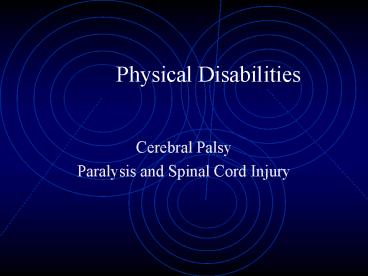Physical Disabilities PowerPoint PPT Presentation
1 / 13
Title: Physical Disabilities
1
Physical Disabilities
- Cerebral Palsy
- Paralysis and Spinal Cord Injury
2
Cerebral Palsy
- Medical term that refers to one of a series of
motor disorders that stem from brain malfunction - Damage to the immature brain
- 4 Diagnostic Criteria for Reflex Problems
- Incidence - 7/1000
- Characteristics -
- Non-hereditary, non-contagious, and
non-progressive - Cause - time of onset
3
Cerebral Palsy Causes and Characteristics
- Prenatal
- Functional disturbances of the mother (may
produce hemorrhages in fetal brain) - Rh incompatibility
- Infection
- Perinatal
- Diseases
- Prolonged or difficult labor
- Anoxic conditions
- Premature birth
Accounts for 90 of all Cases
4
Cerebral Palsy Causes and Characteristics
- Postnatal (10)
- Brain infections
- Poisoning
- Head trauma
- Types of Cerebral Palsy
- Mild to severe
- Based on muscle tone and limbs involved
- 7 distinct types of CP (5 most common)
- 5 anatomical classifications of limbs involved
5
Five Types of Cerebral Palsy
- Spastic - hypertonic muscle tone
- Scissors gait and Hemiplegic gait
- Athetoid - fluctuating muscle tone or dystonia
- Choreoathetosis
- Ataxic - deficient sense of balance,
coordination, and kinesthesis - Cerebellar/kinesthetic gait
- Hypotonia - Low muscle tone (hypotonia)
- Mixed - combination of types (most common
spastic/athetoid)
6
Adapted Devices
- Wheelchairs - VIDEO
- regular
- sport
- electric/manual
- Braces (AFOs, KFOs, AKFOs)
- Canes -
- T, J, Quad
- Crutches / Walkers
7
Anatomical Classification for Limbs Involved
- Monoplegia -
- Diplegia -
- Hemiplegia -
- Triplegia -
- Quadriplegia -
- Other associated characteristics include speech
disorders, seizures, visual/hearing deficits, and
perceptual motor difficulties
8
Paralysis and Spinal Cord Injury (SCI)
- Incidence
- Appx. 10,000 SCI each year in U.S.
- Two categories of paralysis
- paraplegia
- quadriplegia
- Higher lesions less function
- High variability depending on complete or
incomplete
9
Spinal Cord
- Spinal cord 31 pairs of spinal nerves
- Protected by vertebral column
- 24 movable
- 7 cervical
- 12 thoracic
- 5 lumbar
- Spinal cord injuries result from some type of
trauma - Movement and Sensation -
10
(No Transcript)
11
Spinal Cord Injury Classification
- Five-point grading system for extent of injury
(lesion to spinal cord) - 1. Complete
- 2. Incomplete with sensation only
- 3. Incomplete with nonfunctional motor
ability - 4. Incomplete with motor function
- 5. Complete recovery
12
Concerns with Paralysis
- Sensation and Skin Breakdown -
- Temperature Control -
- Contractures -
- Spasms of Spinal Origin -
- Atrophy of Limbs -
- Urination -
- Sexuality -
- Heart and Circulatory Concerns -
- Autonomic Dysreflexia -
- Weight Management and Osteoporosis -
- Depression -
13
Stage One Skin is not broken but is red or
discolored. The redness or change in color does
not fade within 30 minutes after pressure is
removed
Stage Two The epidermis or topmost layer of the
skin is broken, creating a shallow open sore.
Drainage may or may not be present.

